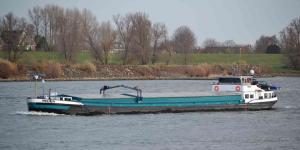Gerrie van Neijenhoff has been tackling the environmental problem for six years. He started with additives to conventional diesel fuel, but according to Van Neijenhoff, that yielded little in terms of greening and a cleaner engine. When Shell launched GTL (Gas to Liquid) — a liquid fuel based on natural gas — he made the switch at his own expense to embark on a trial. “It worked out well. An endoscopy of the engine showed that it was becoming cleaner. We could see it for ourselves at the exhaust — far fewer clouds of smoke and soot. We could see that we were being cleaner — you just notice it in everything, but you can’t prove it on a feeling alone. That’s what measurements and data are for.”
In consultation with Shell, Van Neijenhoff therefore decided to take part in the CLINSH project to demonstrate the impact of GTL on emissions and answer questions like ‘What are your actual emissions at the moment?’ and ‘How clean or polluting are you?’. Since new fuels can often introduce problems that aren’t covered by insurance, Shell is guaranteeing the switch and the measurements. “We started the baseline measurement just a month ago, so it’ll be a little while before we have any real data.”
Reverse investigation
As the engine on the Melvin has been running on GTL for four and a half years now, the investigation for this ship needs to be reversed. This means that the emissions from the GTL fuel will be measured first and then Van Neijenhoff will need to switch back to conventional diesel so that the results can be compared. “Then you’ll see how much more polluting we become — that’s something I know already. You can really see it at the exhaust.” It may be that a few adaptations need to be made to the turbos on the engine, to see if it remains cleaner. “They’re all investigations that are currently ongoing.”
The human side to the environmental problem
Van Neijenhoff expects to be much cleaner with GTL, but for him it’s more about the human side to the environmental problem. “Fine particulate is harmful to humans, and emissions of fine particulate are likely to be around 85% less after switching to GTL.” There are also benefits in terms of NOX and CO2 reduction, and Van Neijenhoff had never expected that the engine would become so much cleaner. “It’s real progress, although GTL is not, of course, 100% clean. For that we’d need to switch to hydrogen.”
What will the CLINSH project be a success at? “Demonstrating exactly how different fuels and technologies relate to one another, and their benefits and drawbacks. Transparency is what convinces people.” For Van Neijenhoff, evidence is crucial. Without evidence, you cannot demonstrate the impact of GTL or convince people of its advantages.
CCR0 versus CCR2
Are there any other low-threshold measures that can help to reduce emissions from inland shipping? Not without difficulty, according to Van Neijenhoff. “You wouldn’t be able to keep your investments under €125,000.” The Melvin is still powered by an old CCR0 engine, an engine with a relatively low fuel consumption. The new CCR2 engines use some 18% more fuel and emit more CO2 as a result. The combination of a CCR0 engine with GTL fuel is actually more sustainable than switching to a new CCR2 engine.
“Not enough consideration is given to the actual footprint of measures. If I take this engine out and scrap it to have another engine made and installed, I’m actually polluting more.” Flawed reasoning which, according to Van Neijenhoff, is all too common. “A catalytic converter with a soot filter would be the only next step, but the investment would be at least €125,000.”
GTL as an intermediate step
For Van Neijenhoff, GTL is just an intermediate step towards a future for his grandchildren. “The current technologies are not yet good enough for cleaner inland shipping. When it comes to powering ships with electricity, the batteries themselves are not environmentally-friendly, and you don’t know where the electricity comes from. That’s why looking for the actual footprint is so critical.”
And who is going to pay for it all? “These investments are ultimately borne by the consumer, and they don’t want to pay for them right now. A second problem is that the inland shipping sector is a hugely fragmented market, with more than 5000 individual vessels in the Netherlands.” How can you create synergies and work together as a single bloc? “Put simply, you need to add a euro onto the freight charge in order to become greener. To be able to make a real transition, we need to join forces and make agreements.”
And in the future?
“In twenty years’ time, inland shipping will still be a relevant industry, certainly container transport, but we need to be realistic.” Greening is coming in the form of hydrogen, which to Van Neijenhoff, is a much better option than electrical shipping. “Shipping is moving towards hydrogen, but it will take time. At the moment, hydrogen based propulsion is the cleanest technology that I can imagine.”

